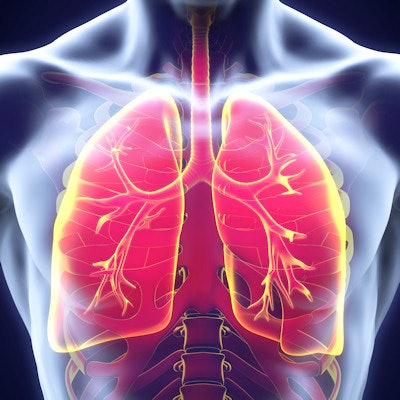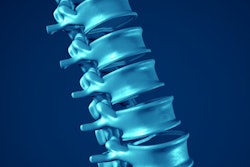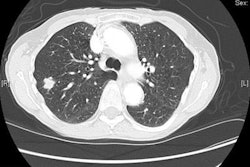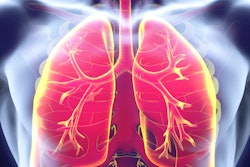
High-risk nonsmokers have lung cancer at rates comparable to those of smokers in the National Lung Screening Trial (NLST), according to a multicenter lung cancer screening trial in Taiwan. If replicated, the results could affect the question of who needs CT lung cancer screening, particularly regarding individuals exposed to secondhand smoke.
The prospective trial examined more than 4,000 nonsmokers ages 55 to 75 who had at least one risk factor for lung cancer, such as a family history or exposure to secondhand smoke. More than 19% had a positive result, and a total of 1.3% had lung cancer, according to results presented at RSNA 2016 in Chicago.
"The prevalence of lung cancer in high-risk nonsmokers at low-dose CT was 1.3%, which is comparable to that of a high-risk smoking group in the National Lung Screening Trial," said Dr. Yung-Liang Wan, chairman and professor of medicine at National Taiwan University College of Medicine in Taipei. "In terms of risk factors in nonsmokers, secondhand smoke is the only statistically significant risk factor." The lead investigator is Dr. Pan-Chyr Yang, PhD, from National Taiwan University.
Lung cancer happens in nonsmokers
All other things being equal, smokers are 35 to 36 times more likely than nonsmokers to be diagnosed with lung cancer. Of course, things aren't equal when it comes to genetic makeup or environmental exposure to carcinogens, and previous studies have shown that there are several factors that can increase cancer risk in nonsmokers, Wan said.
 Dr. Yung-Liang Wan from National Taiwan University.
Dr. Yung-Liang Wan from National Taiwan University.These risk factors include secondhand smoke, family history of tobacco use, tuberculosis or history of chronic obstructive pulmonary disease (COPD), and cooking without ventilation, he said. However, the degree of risk and the association with each factor are not well-understood.
"As many as 10% of people who die from lung cancer in the U.S. each year do not smoke," Wan said.
The percentage is higher -- even up to 50% -- in Taiwan. But little is known about the prevalence of lung cancer in this population, or about the precise contributions of various risk factors. Thus, the purpose of the research was to study the patterns of lung cancer in high-risk nonsmokers using low-dose CT.
Taiwan's Ministry of Health and Welfare sponsored the study, which involved CT lung screening of 4,498 subjects between December 2015 and February 2016. The subjects were 55 to 75 years old (mean age, 61.6 years), had never smoked, or had been light smokers with a 10-pack-year history who had quit more than 15 years ago, along with one additional risk factor.
Patient numbers and the percentage of the patient cohort who had each risk factor are listed below (some patients had more than one risk factor):
- First-, second-, or third-degree family history of lung cancer (n = 1,738, 38.9%)
- Environmental tobacco smoking exposure in the workplace and/or the home (n = 3,382, 75.2%)
- Tuberculosis/COPD (n = 334, 7.4%)
- Cooking index ≥ 110 (weighting scale based on type and duration of cooking indoors) (n = 1,769, 39.3%)
- Cooking without external ventilation (n = 197, 4.4%)
Low-dose CT was acquired mostly in accordance with guidelines from the American College of Radiology (ACR), Wan said. Lesions 5 mm in diameter or smaller were considered negative, with follow-up set for one year later. Ground-glass opacities 6 mm or smaller were considered negative; those 10 mm or larger were followed up in six months or referred for biopsy. Solid or part-solid nodules 6 mm to 8 mm in diameter were followed up in six months, and nodules larger than 10 mm were followed up in three months. The effective radiation dose for screening was 1.064 mSv (standard deviation, 0.316 mSv).
Results comparable to NLST
Among the 4,498 subjects, 19.9% were considered positive on low-dose CT, and 1.64% (n = 72) underwent invasive procedures, according to Wan. Pathology results confirmed 56 cases of lung cancer, for a malignancy rate of 1.3%.
The results were similar to those in the CT arm of the National Lung Screening Trial, which screened only individuals with 30 or more pack-years of smoking history. In the NLST, 24.2% of patients overall were positive, with a total of 292 cancer cases among 26,715 subjects screened with low-dose CT, for a 1.1% incidence.
"The prevalence of lung cancer in high-risk nonsmokers ... is comparable to that of a high-risk smoking group in the NLST," Wan said.
The Taiwan study also revealed 10 cases of minimally invasive adenocarcinoma (MIA) among 40 cases of invasive carcinoma. Of 56 patients with confirmed lung cancers, 96% were stage I or less, he said. There were six cases of adenocarcinoma in situ (AIS), which included ground-glass nodules in four cases and part-solid nodules in two cases. Among the invasive adenomas, 17 were pure ground-glass nodules, 17 were part-solid, and three were solid.
But more ground-glass nodules
Despite the similarities with some previous studies, such as the International Early Lung Cancer Action Program (I-ELCAP), there were also differences. For example, a higher percentage (42%) of ground-glass nodules were adenocarcinomas, and 50% of ground-glass nodules with additional features were adenocarcinomas.
"In the I-ELCAP study, only 4.2% were ground-glass nodules, and lung cancer was diagnosed only in 1.3 cases for every 100 ground-glass nodules in that study, and all ground-glass nodules were stage I," Wan said. "In this study, 42% of ground-glass nodules were adenocarcinomas."
As for limitations, only half of the 72 cases with invasive potential had pathological proof, he said. Also, it is difficult to quantify secondhand smoke as a risk factor, and while half of the adenocarcinomas were pure ground-glass nodules, the density and homogeneity of those nodules were not analyzed.
Lung cancer prevalence in high-risk nonsmokers was comparable to prevalence in a high-risk smoking group in the NLST, Wan concluded. Second, analysis revealed that secondhand smoke was the only statistically significant risk factor (p = 0.031).
"Third, adenocarcinoma in this group is more likely to feature pure [ground-glass nodules] in addition to part-solid nodules," he said, noting that the research is ongoing.
When asked why any patients who had previously smoked were included in the cohort, Wan said the numbers of these subjects were very low.



















